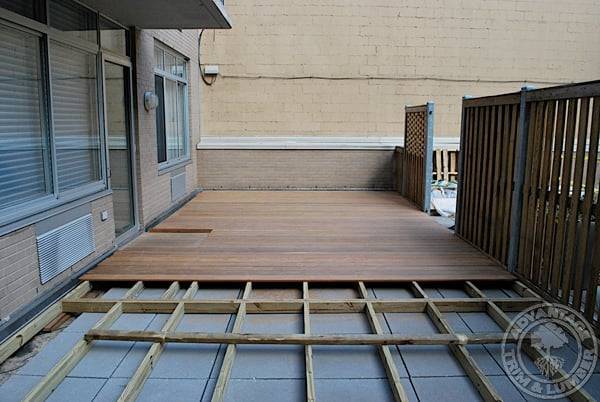
Installing sleepers (aka floor joists) is a reliable way to have a secure deck. Whether you call them floor joists or sleepers, they are just another name given to the frame of a deck that is directly placed on top of concrete (or any other flat surface). Sleepers are usually 2x material and serve as joists for the decking. This method is affordable because of the lack of the substructure material typically needed on regular decks. Building a deck on sleepers does present other problems, however, which can be solved if proper installation, fastening, and ventilation techniques are used. These key conditions need to hold true in order for your deck to last:
- Constant ventilation
- Proper drainage
- Proper hardware
- Correct material for the decking
Ventilation is key to having a successful deck installed on sleepers. Wood, no matter what type it is, will move when there isn’t proper ventilation. Building a deck on sleepers means the space between the concrete and decking will be reduced and ventilation will be limited. Having larger gap spaces between each board and not covering the deck openings with solid fascia boards will increase the airflow throughout the whole deck. With proper ventilation you’ll decrease the chances of warping, cupping, or twisting and increase the lifespan of your deck. Once ventilation is addressed, drainage is the next priority. Traditional decks have the pitch calculated while building the substructure, so adequate drainage is never an afterthought. In decks built on floor joists, it’s completely different. First, you need to establish if the sub surface is pitched. If it’s not, adjustments will need to be made to accommodate water drainage such as cutting sleepers at a slight angle to prevent standing water. The hardware used during the installation process needs to be the highest quality available. With proper hardware, the longevity of the deck will be extended. Hardware includes any screws, connectors, or fasteners used during the building process. For any deck installation we always recommend using stainless steel screws. These screws are the most resistant to nature’s damaging elements. When holding down the deck boards, you can use hidden fastening systems as long as they penetrate both the board and joist itself. The best method however is face-screwing the boards. The screws will have a higher holding power than any other system especially under increased moisture conditions. Choosing the right board profile is just as important as choosing the right fastener. Narrower and thicker boards have a higher resistance to malformation. Think about the choices and dimensions of the lumber you will use for your decking. Considering all these options and doing your homework on each material will decrease the likelihood of future problems. Using sleepers for your framing is a different approach when constructing a deck . Choosing the right materials and installing them correctly will guarantee the longevity of your deck for years to come.
Thanks for pointing out that constant ventilation and proper drainage are key conditions for a deck to last. My current deck is in poor shape after a few years of use and multiple severe storms it’s been through, so I would like to renovate it. I was thinking of getting concrete sleepers, so I’ll be careful with allowing for ventilation.